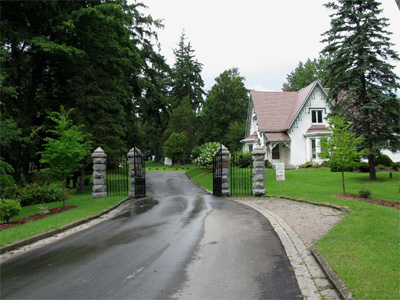Cataraqui Cemetery National Historic Site of Canada
Kingston, Ontario

Entrance to the cemetery
© Parks Canada / Parcs Canada, 2009 (Rhona Goodspeed)
Address :
927 Purdy’s Mill Road, Cataraqui, Kingston, Ontario
Recognition Statute:
Historic Sites and Monuments Act (R.S.C., 1985, c. H-4)
Designation Date:
2011-07-19
Dates:
-
1850 to 1850
(Established)
-
1864 to 1894
(Addition)
-
1907 to 1907
(Other addition)
Event, Person, Organization:
-
Sir John A. Macdonald National Historic Person
(Person)
-
Sir Alexander Campbell National Historic Person
(Person)
-
Frederick James Mott Cornell
(Architect)
Other Name(s):
-
Cataraqui Cemetery
(Designation Name)
Research Report Number:
2009-080
Plaque(s)
Existing plaque: 927 Purdy’s Mill Road, Kingston, Ontario
Established in 1850 to plans by Frederick Cornell, Cataraqui is a well-preserved example of a medium-sized rural cemetery in Canada and the resting place of many prominent Canadians. With its uneven topography, curvilinear roads, water features, picturesque views, and variety of plantings, Cataraqui reflects the aesthetics of 19th-century-American rural cemeteries, designed as an alternative to crowded urban graveyards. A Gothic Revival lodge, elegant funerary monuments, and sculptures are scattered amidst a natural setting that inspires contemplation and remembrance.
Description of Historic Place
The Cataraqui Cemetery National Historic Site of Canada is located in the greater area of Kingston, Ontario. Designed by Frederick Cornell and established as a non-denominational cemetery in 1850, the park-like Cataraqui Cemetery now covers approximately 40 hectares and is a medium-sized rural garden cemetery laid out according to Picturesque design principles. It features a naturalistic, treed landscape, winding paths and many funerary monuments of varying types, styles set within a rolling topography. Official recognition refers to the cemetery in its defined boundary including landscape elements, roads, monuments, fountains and buildings varying in size and function.
Heritage Value
The Cataraqui Cemetery was designated a national historic site of Canada because:
— it is an attractive and well preserved example of a medium-sized rural cemetery characterized by its uneven topography and naturalistic landscape with many varied perspectives laid out in the Picturesque manner, its curvilinear roads and islets of irregular curved shapes and differing sizes, its ponds, and its range of plantings including many mature trees;
— it includes a number of funerary monuments of artistic and historical interest that are an exceptional illustration of many aspects of the history of Canada, the province of Ontario, and the City of Kingston, and is the final resting place for many prominent Canadians, including Sir John A. Macdonald; and,
— it includes a Gothic Revival-style Lodge carefully designed to complement the naturalistic and Picturesque values of the site, as well as, among its decorative features, a number of attractive painted iron and zinc sculptures from the second half of the 19th century, including a number of female allegorical figures.
The heritage value of the Cataraqui Cemetery lies in its design and physical features. Cataraqui Cemetery belongs within the tradition of rural cemeteries that developed during the 19th century and found expression in many parts of Canada from the late 1840s to the 1870s. Cataraqui is an early and very good expression of the rural cemetery in its use of a naturalistic setting to attract and comfort the living, its creation of a secure space for the dead, its use of funerary monuments to perpetuate the memory of the deceased, and its layout as a park-like space for public use with a variety of species of trees and shrubs. Cataraqui Cemetery has retained nearly all of its characteristic features as they were originally set out, including its many Picturesque views within the grounds. It is also noteworthy for its attractive examples of late 19th century decorative statuary placed throughout the grounds. Established three miles out of Kingston, the cemetery is now located within the boundaries of Kingston.
Character-Defining Elements
Key elements contributing to the heritage value of the Cataraqui Cemetery include:
— the cemetery’s location in Kingston;
— its rural design and natural setting, reminiscent of the design of rural cemeteries pioneered in France and the United States at the beginning of the 19th century;
— the site’s dramatic and diverse undulating topography dominated by natural features, particularly ravines, swales and streams, and diverse varieties of mature trees, shrubs, plants and ponds that achieve a pastoral appearance;
— the landscape of approximately 40 hectares, within generally rectangular boundaries, laid out in a park-like manner with planning in the “picturesque” style, design, with the placement and juxtaposition of manmade and natural features that combine to create panoramic perspectives that include lawns, mature trees, shrubs, serpentine roads and paths, funerary monuments, urns, flowerpots, and female allegorical figures;
— the two main roads running the length of the cemetery, merging at either end and joined by short curvilinear roads;
— the definition of the cemetery boundaries by fences, walls and gates and those original entrance gates in their location, design, materials and craftsmanship;
— the abundance and variety of the funerary monuments ranging in style, size and materials, which have historical associations for the city, province or nation;
— the large monuments and tombs of architectural and sculptural merit, and the gravesites of notable Canadians including Sir John A. Macdonald, Canada’s first prime minister; - the associated buildings and structures, including the Lodge, an office/crematorium, two vaults, an outdoor chapel, root cellar and greenhouses;
— the park-like panoramic viewscapes within the cemetery.